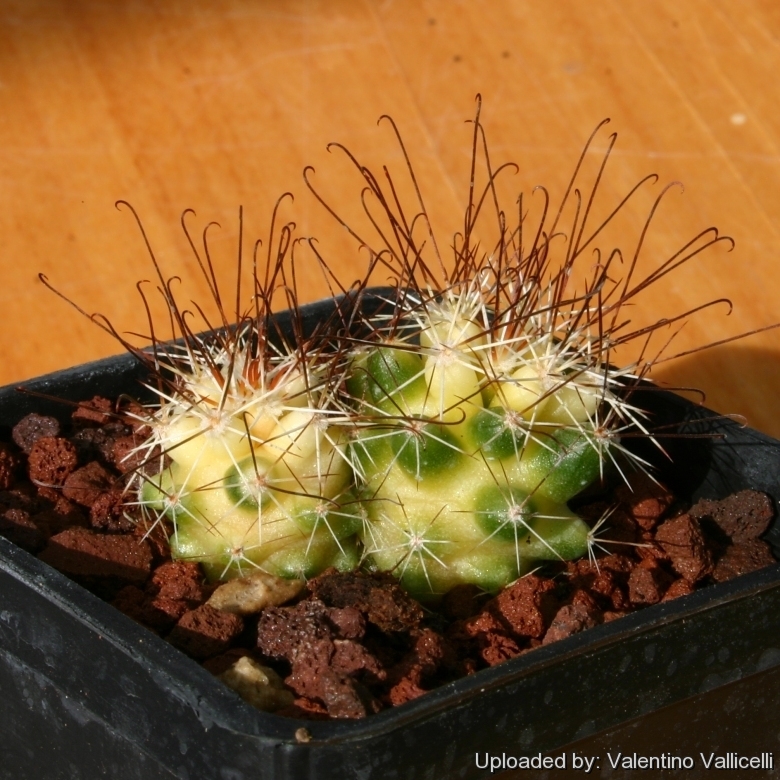Accepted Scientific Name: Coryphantha odorata f. variegata hort.

Cumarinia odorata f. variegata (Coryphantha odorata f. variegata) Photo by: Valentino Vallicelli
Origin and Habitat: Garden origin (Nursery produced cultivar)
Synonyms:
See all synonyms of Coryphantha odorata
Description: Coryphantha odorataSN|10354]]SN|10354]] is a small clustering cactus which clusters at an early age.
The forma variegata has sectors, patches or stripes with pale yellow colours, even distinct shades of green. Plants with variegated stems are often attractive and highly prized. Because the variegation is due to the presence of two kinds of plant tissue, propagating the plant must be by a vegetative method of propagation that preserves both types of tissue in relation to each other.
Stem: Globose or elonged up to 4 cm tall, up to 3 cm in diameter.
Tubercles: Cylindrical, soft 1 cm long with hairy axils. There is a shallow groove on the upper part.
Central spines: 3 or 4 all hooked black, dark-reddish to yellow, up to 2,5 cm long,
Radial spines: 7 to 9 short white, or yellow, with brownish tips
Flowers: Diurnal, small, 1,2 cm in diameter, 1,5 cm long, yellowish pink in appreciable numbers at an early age.
Subspecies, varieties, forms and cultivars of plants belonging to the Coryphantha odorata group
Bibliography: Major references and further lectures
1) Nathaniel Lord Britton, Joseph Nelson Rose “Cactaceae: Descriptions and Illustrations of Plants of the Cactus Family” Courier Dover Publications, 1963
2) Edward Anderson “The Cactus family” Timber Press, Incorporated, 2001
3) James Cullen, Sabina G. Knees, H. Suzanne Cubey "The European Garden Flora Flowering Plants: A Manual for the Identification of Plants Cultivated in Europe, Both Out-of-Doors and Under Glass" Cambridge University Press, 11/Aug/2011
4) David R Hunt; Nigel P Taylor; Graham Charles; International Cactaceae Systematics Group. "The New Cactus Lexicon" dh books, 2006
Cultivation and Propagation: Variegated cacti are regarded as choice and difficult in cultivation, but despite that many of them are relatively easy to grow. But be aware that they cannot tolerate prolonged exposure to direct sun light (especially during the hottest summer days), so grow them in half-shade or under filtered sun. They are sometime seen as grafted plants, but some of this colourful plants (those with some chlorophyll) are able to grow on their own roots and are priced by collectors.
Soil: Use mineral well-permeable substratum with little organic matter (peat, humus).
Watering: Water sparingly from March till October, and keep perfectly dry in winter, at temperatures from 5 to 15 degrees centigrade. (In general these plants are more tender and cannot endure freezing temperatures). In the rest period no high atmospheric humidity!!
Propagation: By seeds, grafting or cutting. Because the variegation is due to the presence of two kinds of plant tissue, propagating the plant must be by a vegetative method of propagation that preserves both types of tissue in relation to each other. A most common way way to cultivate this partially de-coloured cultivars is to graft them onto another cactus which has chlorophyll and which will provide sugar to the mutant scion. The chlorophyll containing bottom part of the graft, called the stock, can be any number of different columnar cactus species.
Remarks: Seeds from variegated parents often give raise to some variegated seedlings too.











